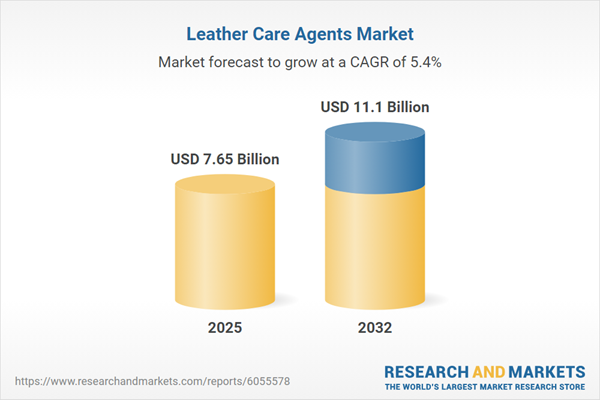Speak directly to the analyst to clarify any post sales queries you may have.
The leather care agents market stands at a pivotal intersection of sustainability, evolving consumer preferences, and technological innovation, presenting transformative growth opportunities across industries reliant on premium leather products. Senior stakeholders are evaluating strategic directions to secure competitive advantage within this dynamic sector.
Market Snapshot: Leather Care Agents Market Size & Trajectory
The leather care agents market grew from USD 7.29 billion in 2024 to USD 7.65 billion in 2025 and is forecast to expand at a CAGR of 5.39%, reaching USD 11.10 billion by 2032. This growth is underpinned by rising demand for specialized, sustainable formulations and shifting regulatory and consumer priorities across global regions.
Scope & Segmentation: Comprehensive Industry Coverage
This report dissects the leather care agents market through a multi-angle lens, equipping decision-makers with granular insights for strategy development:
- Product Types: Balms, cleaners, conditioners, polishes, protector sprays, wipes
- Leather Types: Bonded leather, full grain leather, genuine leather, split grain leather, top grain leather
- Treatment Types: Color enhancement, lubrication, stain removal, waterproofing
- Formulation Approaches: Natural-based (animal-derived ingredients, plant-based ingredients), synthetic formulations
- Distribution Channels: Offline stores, online stores
- End-User Applications: Apparel, automotive interiors, equestrian equipment, footwear, furniture
- Geographies Covered: Americas (including United States, Canada, Mexico, Brazil, Argentina, Chile, Colombia, Peru), Europe (United Kingdom, Germany, France, Russia, Italy, Spain, Netherlands, Sweden, Poland, Switzerland), Middle East (UAE, Saudi Arabia, Qatar, Turkey, Israel), Africa (South Africa, Nigeria, Egypt, Kenya), Asia-Pacific (China, India, Japan, Australia, South Korea, Indonesia, Thailand, Malaysia, Singapore, Taiwan)
- Companies Profiled: 3M Company, Angelus Shoe Polish, Chamberlain's Leather Milk, Cobbler's Choice, Collonil, Crep Protect Ltd, Fiebing Company, Inc., Huberd Shoe Grease Co., Leather Honey, Lexol Leather Care, Meguiar's, Inc., Nikwax Ltd., Otter Wax, Perfect Hygiene Industries LLC, Saphir Beauté du Cuir, SC Johnson & Son, Inc., Tata International, Turtle Wax, Inc., Urad Leather Care, Weiman Products, LLC, WetWipesPro
Key Takeaways: Strategic Insights for Senior Leadership
- Technological innovation is accelerating, with new biopolymer and enzyme-based formulations offering superior efficacy while addressing environmental concerns.
- Consumer demand is shifting toward transparent labeling, eco-certifications, and ingredient disclosures, influencing product development and marketing strategies.
- Sustainability imperatives are driving manufacturers to adopt plant-derived and recyclable components across the product lifecycle.
- Regional regulatory differences impact the adoption of eco-friendly practices, with Europe, Middle East, and Africa focusing on chemical safety, while Asia-Pacific's urbanization creates new demand clusters.
- Brand credibility and service integration, notably through professional-grade solutions and digital engagement, are becoming key to differentiation and long-term customer loyalty.
Tariff Impact: Navigating Supply Chain and Cost Pressures
Recent United States tariff adjustments on imported raw materials—including surfactants and packaging substrates—have required supply chain realignment and alternative sourcing. This restructuring favors nearshore production and optimized inventory management, enhancing resilience and cost stability as trade dynamics evolve.
Methodology & Data Sources
Research is built on a framework of primary interviews with executives, product formulators, and procurement specialists, combined with structured surveys across end-user segments. Secondary data incorporates trade association reports, regulatory filings, supplier documentation, and financial disclosures, validated through triangulation and scenario analysis. Adherence to strict research protocols assures reliability and insight integrity.
Why This Report Matters
- Enables data-driven decisions by detailing growth opportunities, segment trends, and regulatory impacts tailored for executive planning.
- Delivers actionable guidance for supply chain resilience, sustainability adoption, and competitive positioning in an evolving market.
- Empowers stakeholders to benchmark strategies against leading players, anticipate policy shifts, and unlock new channels for growth.
Conclusion
Decision-makers accessing this report gain clear, focused guidance to anticipate change, align strategies, and harness emerging opportunities in the leather care agents market. With a comprehensive, segment-specific analysis, stakeholders can chart robust growth paths across regional and application domains.
Table of Contents
3. Executive Summary
4. Market Overview
7. Cumulative Impact of Artificial Intelligence 2025
Companies Mentioned
The companies profiled in this Leather Care Agents market report include:- 3M Company
- Angelus Shoe Polish
- Chamberlain's Leather Milk
- Cobbler's Choice
- Collonil
- Crep Protect Ltd
- Fiebing Company, Inc.
- Huberd Shoe Grease Co.
- Leather Honey
- Lexol Leather Care
- Meguiar's, Inc.
- Nikwax Ltd.
- Otter Wax
- Perfect Hygiene Industries LLC
- Saphir Beauté du Cuir
- SC Johnson & Son, Inc.
- Tata International
- Turtle Wax, Inc.
- Urad Leather Care
- Weiman Products, LLC
- WetWipesPro
Table Information
| Report Attribute | Details |
|---|---|
| No. of Pages | 185 |
| Published | November 2025 |
| Forecast Period | 2025 - 2032 |
| Estimated Market Value ( USD | $ 7.65 Billion |
| Forecasted Market Value ( USD | $ 11.1 Billion |
| Compound Annual Growth Rate | 5.3% |
| Regions Covered | Global |
| No. of Companies Mentioned | 22 |








